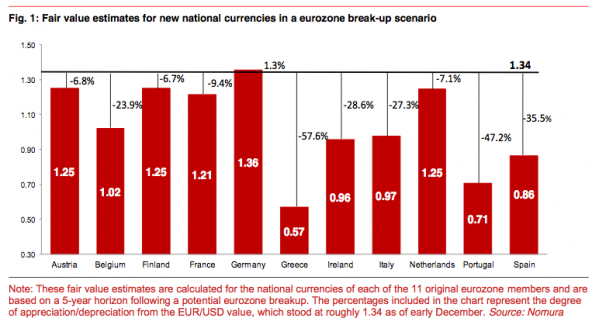Before 1948 nearly one million Jews lived in the MENA region (Middle-East & North Africa) outside of the sc Brittish Palestinian mandate; after a half decade only few thousend were left. A documentary movie ”The Forgotten Refugees” gives some background to these Jewish communities in the Great Middle East.

Wider context of the Refugee question in MENA
Thriving, prosperous Jewish communities existed in the Middle East and North Africa ( aka MENA region) a thousand years before the rise of Islam and more than 2500 years before the birth of the modern Arab nations. These communities, which extended from Iraq in the east to Morocco in the west, enjoyed a lively fabric of life and were influential in the local economies. Until the 10th century C.E., 90% of the world's Jews lived in regions now known as Arab countries.

On Nov. 29, 1947, the UN voted to partition then British-Mandate Palestine into two states: one Jewish, one Arab. Two states for two peoples. The Jewish population accepted that plan and declared a new state in its ancient homeland but the Arab inhabitants rejected the plan and launched a war of annihilation against the new Jewish state, joined by the armies of five Arab members of the UN. As a result of the war, there were Arabs who became refugees. Also following the declaration of the Jewish state antisemitism and anti-Jewish riots broke out in the Middle East and North Africa ( aka MENA region) and many Jews were driven from their homes - between 1948 and 1952, 856,000 Jews from Arab countries became refugees.
Besides humanitarian aspect I could mention an economic one too. In a recent conference "Justice for Jewish Refugees from Arab Countries" Dr. Stanley Urman, the executive director of Justice for Jews from Arab Countries, noted that Jewish refugees lost property worth $700 million (around $6 billion in today's terms ), while Palestinian refugees lost property worth about $450 million (around $3.9 billion in today's terms ). Since 1950, he said, Palestinian refugees have received $13.7 billion in U.N. funding, whereas Jewish refugees have received just $35,000. (Source Haaretz )
UNRWA – the never-ending mission
 At least two aspects explain why there are still refugees after more than six decades:
At least two aspects explain why there are still refugees after more than six decades: - First is Arab leaders' recalcitrance to accept their brethren and refusing to absorb the Palestinian refugees.
- Second the United Nations created a separate agency - UN Relief and Works Agency (UNRWA) - with unique principles and criteria.
Originally UNRWA was established as a temporary agency. One motivation to agency's refugee definations might be economic aspect. An article ”Palestinians Refugees Forever” in Haaretz gives following background:
UNRWA states that the Palestinians are occupied - indefinitely. UNRWA has financial and political interests in maintaining this fiction: as long as the Palestinians are refugees, UNRWA is in business. Of the 30,000 people that UNRWA employs, the vast majority are Palestinian: UNRWA is the largest single employer of Palestinians in Gaza and the West Bank. Contrast this to the UN High Commission for Refugees, that only employs 5-6,000 people globally, and which focuses far more clearly on resettlement and rehabilitation of refugees and building new lives, and not on maintaining services that prop up the status quo. (Source Haaretz )Refugees without agency
Millions of Germans who had lived in the Sudetenland and were kicked out at the end of WWII (3 years before 1948). They were not allowed to return and they are no longer refugees because Germany absorbed them. Finland settled some 10 % of its population from territories occupied by the Soviet Union, which from its side transferred new population to new regions. Around 45,000 Hungarians were deported from Czechoslovakia to Hungary, while around 72,000 Slovaks transferred from Hungary to Czechoslovakia, and they are no longer refugees either. Hundreds of thousands of Cypriots who were kicked out of their homes were also not allowed to go back to them, and they are no longer refugees because their fellow nationals on the other side of the island absorbed them.
 One
aspect with “right of return” should now be highlighted: A recent
ruling by the European court of human rights declared that due to the
time that had elapsed, Greek refugees expelled from northern Cyprus in
1974 would not be allowed to return to their homes. Now while, tiny
Israel absorbed the Jewish refugees, but the vast Arab world not the
Palestinian refugees – defined by unique UNRWA criteria – the discussion
of ”right to return” has so far been quite one-sided.
One
aspect with “right of return” should now be highlighted: A recent
ruling by the European court of human rights declared that due to the
time that had elapsed, Greek refugees expelled from northern Cyprus in
1974 would not be allowed to return to their homes. Now while, tiny
Israel absorbed the Jewish refugees, but the vast Arab world not the
Palestinian refugees – defined by unique UNRWA criteria – the discussion
of ”right to return” has so far been quite one-sided.Israeli point of view
Earlier Israel's Deputy Minister of Foreign Affairs Danny Ayalon published his view in informative video ”The Truth About the Refugees” explaining the historical facts relating to the issue of refugees in the Israeli Palestinian conflict. This video also highlights the issue of the Jewish refugees who were forced out of their homes in the Arab world, and were subsequently absorbed by the State of Israel.

Organisation ”Jews Indigenous to the Middle East and North Africa” ( JIMENA ) has completed their first comprehensive country specific websites about refugee issue:
- Egyptian Experience ,
- Iraqi Experience ,
- Libyan Experience ,
- Yemenite Experience ,
- Moroccan Experience ,
- Tunisian Experience and
- Algerian Experience
Unsolved Israeli-Palestinian conflict squanders resources which in more peaceful circumstances could be used for capacity building of civil societies. Keeping refugee question and land dispute on the top of their agenda Palestinian Authorities favor temporary solutions and relief instead of building more permanent institutions. On Israeli side the defense and security takes more and more resources, e.g one Iron Dome missile to drop one Quassam rocket costs nearly $ 100.000. Then there is also a question about effectiveness of foreign aid, but that is the other story outside the issue of this article (see e.g Placebo effect for people and society with 20 bn bucks).
In my opinion the Palestinian refugees should be rehabilitated in their place of residence just as the Jewish refugees were rehabilitated in theirs - Israel. There should be an immediate discontinuation of the perpetuation of the Palestinian refugee issue. The rehabilitation process implemented this way would minimize the demand for the "right of return" during peace talks so one problem less in agenda. Sure few years ago there was a preliminary agreement about Palestine returns in Israel but the number was rather symbolic ( 5.000 ). In any case the insistence of some Palestinian refugees to be given a right of return will be resolved by their immigration into the future Palestinian state that will be established through a peace agreement.
In my opinion the refugee problem described above has some similarities with situation in Serbia after Balkan wars. In Serbia still lives over 200.000 refugees and IDPs (internaly displaced persons). Like return of Jews back to Arab countries, like return of Palestinians to Israel or West-Bank as well return of Serbs back to Croatia or Kosovo the numbers of returns are insignificant e.g due security reasons. From my point of view to solve refugee/IDP problem the rehabilitation process in the place of residence is good alternative and international aid should be redirected e.g towards effective housing programs instead of keeping alive unrealistic dreams about going back to square one.

¤¤¤ ¤¤¤ ¤¤¤
Some of my related articles:- About population movements: “Gaza War – Could Balkan history show way out?” and The Third Intifada – To Fade or Escalate
- About the Three-State-Option “The Three-State Option could solve Gaza conflict”
- About Peace process: “PaliLeaks, land swaps and desperate search of peace”
- Refugees and IDPs after Balkan wars: “Forgotten Refugees – West Balkans”
¤¤¤ ¤¤¤ ¤¤¤






 T
T


 Now
Eurozone as well EU as construction is on the verge of tumbling down.
EU bureaucracy is implementing their only truth by trying to guide EU
towards federation. Earlier agreements in Maastricht, Barcelona and
Lisbon were only soft exercises. Now financial crisis has enabled
stronger methods. In March 2011 a new reform of the
Now
Eurozone as well EU as construction is on the verge of tumbling down.
EU bureaucracy is implementing their only truth by trying to guide EU
towards federation. Earlier agreements in Maastricht, Barcelona and
Lisbon were only soft exercises. Now financial crisis has enabled
stronger methods. In March 2011 a new reform of the  The
investors face normally e.g Interest rate risk, credit (i.e default)
risk, volatility risk, structure risk, counter-party credit risk,
prepayment risk, general market risk, liquidity risk, extension risk,
transparency risk, political risk, and currency risk and now also with
Euro a dissolution risk. As said this is normal and because of those
risks also the profits are huge. But the basic principle in is that with
investments and not to speak even speculations there is two sides –
wins and losses. In my opinion the loss should no more be paid by
taxpayers.
The
investors face normally e.g Interest rate risk, credit (i.e default)
risk, volatility risk, structure risk, counter-party credit risk,
prepayment risk, general market risk, liquidity risk, extension risk,
transparency risk, political risk, and currency risk and now also with
Euro a dissolution risk. As said this is normal and because of those
risks also the profits are huge. But the basic principle in is that with
investments and not to speak even speculations there is two sides –
wins and losses. In my opinion the loss should no more be paid by
taxpayers.